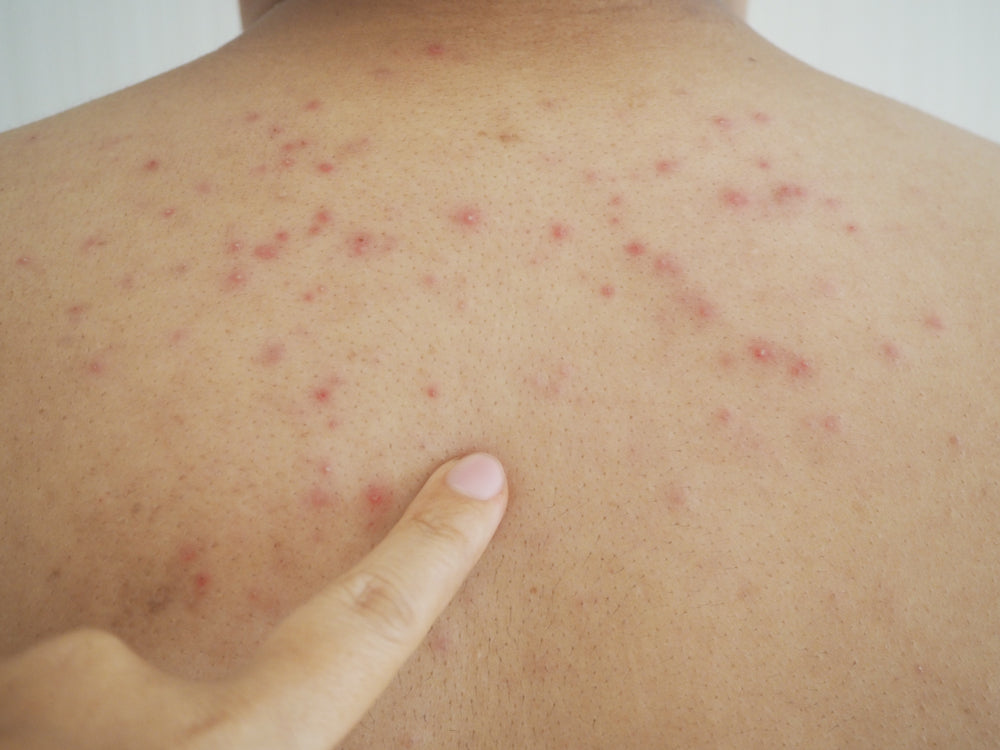Free U.S. Shipping On Orders Over $150

Mapping Body Acne: What Breakouts on Different Parts of Your Face and Body Mean
Posted on
Where an acne breakout appears can be an indicator of what’s causing it. On your face, acne appearing around your hairline and temples is likely caused by hair products while acne on your jawline is probably hormonal.
In this post, we’ll do the same kind of mapping, but for body acne that appears on your chest, back, and other areas of your body.
Importance of Mapping Body Acne
Skin acne can be a frustrating condition. Often, it’s not clear what’s causing it, which makes it harder to treat. Even if you successfully clear it, it can come back if you have not fixed the root issue.
Mapping body acne is one of the ways you can figure out what’s causing the breakouts. If you keep getting a breakout in the same place every time, you can begin to narrow down possible causes.
Acne mapping is not an exact science. Acne caused by hormones, diet or some other cause can appear anywhere on your body depending on your genetics and other factors. We recommend trying multiple solutions and talking to a dermatologist if you have persistent breakouts.
Where Does Body Acne Occur?
Body acne can appear anywhere on your skin where there are oil or sebaceous glands and hair follicles. That means you can get acne anywhere except the soles of your feet and palms of your hands.
That said, there are specific areas where body acne is most common. These include the chest, back, neck and shoulders.
Types of Body Acne and What They Mean
Neck Acne
Neck acne can be an extension of hormonal acne. In that case, it will start around the jawline, spread to the chin and reach the upper neck.
Acne on the upper part of your neck can also be caused by products that you use on your face like makeup or cream.
If the acne occurs lower on your face, the likely cause is your clothing. Constant rubbing and friction from the collar of your shirt or the neckline of your top could be causing friction acne, also called acne mechanica.
Heat and sweat can also cause neck acne. So if your neck often gets damp with sweat, that could be the reason for the breakout.
Shoulder and Back Acne
Shoulder and back acne is commonly caused by friction. If you often carry a backpack, wear shoulder pads or have clothes that rub against your shoulders, the friction can lead to a breakout.
For people with long hair that touches the shoulders and back, hair products can also clog pores and cause an acne breakout.
Sweat is another common cause of shoulder and back acne, particularly for people who workout out or play sports.
Shoulder and back acne can also be hormonal. You can usually tell hormones are the cause if the breakout occurs around the same time each month, they occur during pregnancy or you experience them for the first time during menopause.
Acne on your shoulders and back can also be dietary. High glycemic index foods are linked to acne breakouts.
Chest Acne
The chest contains more sebaceous glands than other areas of the body, so chest acne is quite common. The most common causes include poor skin care, the type of skin products you use, friction from clothes, and sweat.
Diet and hormones can also lead to breakouts on your chest.
Stomach Acne
The further down you go, the less common acne becomes. So stomach acne is not a common sight.
If you have a breakout on your stomach, it’s probably a build up of sweat, the skin products you are using or friction from your clothes.
Acne on Your Lower Body
Acne on your butt and thighs is usually linked to your clothing. Wearing tight clothing such as tight briefs or too-tight pants can lead to excess friction and sweat, causing an acne breakout.
Hygiene around your essential areas can also be a cause. Dirty underwear can transfer bacteria, dirt, sweat and oils onto the skin and lead to painful cystic acne.
How to Treat and Prevent Body Acne
- Moisturize your body the same way you moisturize your face. Dry skin makes acne breakouts more likely. Don’t forget to exfoliate your body 1-2 times a week to reduce buildup of dead skin cells and oils.
- Wear well fitting clothes that don’t rub against the skin, causing friction and chaffing.
- Be careful about which hair products you use. Pick those that won’t cause acne on your skin or find a way to keep hair products from getting onto your skin.
- After a workout, shower and change immediately to avoid sweat acne.
- Wear sweat-wicking clothing to prevent sweat from getting trapped on your skin. This is especially important for sports and physical activities. Our Hercleon HercShirt is breathable, sweat-wicking and even anti-bacterial. It keeps you smelling fresh and prevents acne breakouts.
Quick links
Contact
6063 Hudson Road #160
Woodbury, MN 55125
Yo@hercLeon.com
Leave a comment: